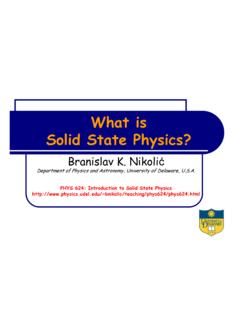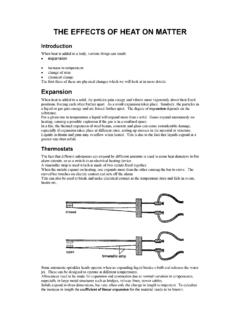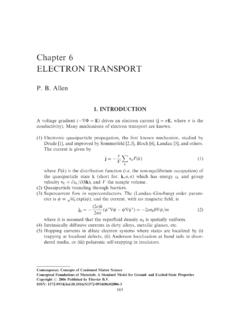Transcription of Dow Liquid Separations DOWEX Ion Exchange Resin Guide …
1 DowLiquid SeparationsDOWEXIon Exchange Resin Guide to Condensate PolishingMay 2003 Page 2 of 23* Trademark of The Dow Chemical CompanyForm No. 177-01331-503 DOWEX Ion Exchange ResinsTable of ContentsAn Introduction to Condensate PolishingCondensate Polishing A Preventative Approach3 The Role of Ion Exchange in Condensate Polishing3 The Purpose of This Guide4 The Type of Condensate Polishing Operation Depends on the Operating Parameters Boiler Pressure4 Condensate Polishing Systems Currently Used or Proposed for OperationCation Exchange Condensate Scavenging 5 Cation/Anion Mixed Bed5 Lead Cation Resin Followed by Mixed Bed of Strong Cation/Strong Anion Resins7 Cation-Anion Stacked Bed (Tripol System)
2 7 Operating Cycle Options DOWEX * Resin Selections for Condensate Polishing8 Hydrogen Cycle Operation9 BWR Primary Cycle Neutral pH Condensate9 Hydrogen Cycle with All Volatile Treatment (AVT)10 The Ammonia Cycle with All Volatile Treatment (AVT)10 Morpholine, Ethanolamine and Other Alternative Amines11 Use of Boric Acid in PWR Secondary Cycles for Intergranular Attack and Stress Corrosion Cracking Control13 Factors Affecting Resin Performance Resin Characteristics (Cation and Anion)13 Particle Size Uniformity13 Particle Size Uniformity and Separability for Regeneration15 Filtration15 Capacity15 Selectivity15 Bead Integrity16 Kinetics16 Oxidative Stability17 Rinse and Regeneration Efficiency17 Color17 Resins Specifications Can Help You Select the Right Resin17 System Operating ConsiderationsTemperature18 Organics18 Regeneration18 Separation18 Regenerants20 Remixing Resin20 System Operation20 Dow Technical BackupReferencesFiguresFigure 1.
3 Typical Steam Turbine Loop3 Figure 2. Particulate Filtration in a Typical Cation/Anion Mixed Bed5 Figure 3. Battery of Condensate Polishers6 Figure 4. Typical External Regeneration System6 Figure 5. Lead Cation Resin with Mixed Bed Condensate Polisher7 Figure 6. Cation-Anion-Cation Stacked Bed7 Figure 7. Effluent Iron from New Resin Beds vs. Control Resin Bed Nine Mile Station Unit 29 Figure 8. Cation Resin Selectivity vs. Cross-Linkage10 Figure 9. Resin Beads with Gaussian and Narrow Size Distributions13 Figure 10. Condensate Polisher Performance DOWEX MONOSPHERE* Resin Simulated Condenser Seawater Leak Studies14 Figure 11. Condensate Polisher Performance DOWEX MONOSPHERE Resin During Actual Condenser Leak14 Figure 12.
4 Sodium Ion Leakage Based on Equilibria with Hydrogen Ion16 Figure 13. Chloride Ion Leakage Based on Equilibria with Hydroxide Ion16 Figure 14. Anion Rinse Down Curves DOWEX MONOSPHERE Resins vs. Gaussian Gel Resins17 Figure 15. Terminal Settling Velocity Distributions and After-Backwash Column Profiles for Gaussian and Narrow Size Distribution Resins in Mixed Beds19 TablesTable 1. EPRI Guidelines to Maximum Impurity Levels in PWR Steam Generator and BWR Reactor Water Systems5 Table 2. Typical Bulk Properties (H+ Form) for DOWEX Cation Exchange Resins8 Table 3. Typical Bulk Properties (OH- Form) for DOWEX Anion Exchange Resins8 Table 4. Typical Ratios of Cation to Anion Resin Used in Mixed Bed Condensate Polishing8 Table 5.
5 Results Summary for the Controlled Aging Studies (150 F/65 C) for Several Prototypes of the DOWEX MONOSPHERE 575C versus the DOWEX MONOSPHERE 650C Cation Resins12 Page 3 of 23* Trademark of The Dow Chemical CompanyForm No. 177-01331-503 DOWEX Ion Exchange ResinsAn Introduction to Condensate PolishingCondensate Polishing A Preventative ApproachCondensate polishing is an important part of water treatment for any utility or industrial power generating system. Thisincludes power generating facilities using once-through steam generators (OTSG), critical and supercritical steamgenerators, nuclear-fueled boiling water reactors (BWR) and pressurized water reactors (PWR).
6 Figure 1 is a block diagram of a typical steam-condensate loop. As shown in this diagram, steam from the boiler passesthrough a series of turbines and expends most of its energy. The low-pressure steam is then condensed in a heatexchanger system where it is recovered in hotwells and routed to storage tanks. This condensed water or condensate isthen recycled to the boiler and converted back into steam. The continuous cycling or re-circulation of the steam andcondensate is commonly referred to as the steam-condensate loop or steam-condensate cycle. Recovering and recyclingthe return condensate stream is an obvious way to significantly reduce the cost of operation.
7 Within this cycle, some water is lost due to leaks and boiler blowdown, so a continuous make-up water source is required tomaintain the total energy within the cycle. A local river, lake or well is used as the source for make-up water. In order tomaintain a feedwater stream with a low level of dissolved solids the raw water is demineralized using ion Exchange (IX)resins, reverse osmosis (RO) membranes or a combination thereof. In some cases, demineralization of the make-up wateris accomplished via evaporation. Regardless of the technology, the operation is commonly referred to as the make-up waterdemineralizer system. In most cases, the make-up water is injected into the condenser hotwells or storage boiler make-up water is only one determinant of feedwater purity, the other being the condensate return stream.
8 In fact,condensate purity is of greatest concern in high-pressure utility units, where condensate represents the bulk of boilerfeedwater, making it the major potential source of contaminant introduction. To this end, purification or polishing of thereturn condensate is an essential ingredient to guarantee a high quality feedwater stream to the downstream Role of Ion Exchange in Condensate PolishingThe role of ion Exchange technology is fundamental to condensate polishing. And condensate polishing is a uniqueapplication for ion Exchange resins. Unlike treatment of make-up water, the condensate polishing system must dealprincipally with impurities that arise inside the steam system itself, rather than those that figure in the raw water include a return condensate stream with a limitless inventory of impurities solid, gel-like, and dissolved.
9 Theseimpurities originate from a host of sources, such as vacuum-induced leaks, corrosion of metal surfaces and careless repairwork. Under normal conditions the raw condensate is considered high quality with respect to dissolved contaminants,however, corrosion products are picked up as the steam and condensed water pass through piping, heat exchangers andother associated equipment in the steam-condensate loop. A far more serious threat is the inleakage of dissolvedcontaminants that occurs when cooling water in the condenser system leaks into the condensate stream. For these reasons,condensate polishing is an operation that cannot be taken casually or 1. Typical Steam Turbine LoopEconomizerBlowdownBoilerReheat SteamH-P HeatersL-P HeatersDeaeratorCondenserHotwellCooling WaterSaturatedSteamHPTurbineIPTurbineLPT urbineCondensateStorageCondensatePolishe rsMake-UpDemineralizationWater SystemRaw Water Page 4 of 23* Trademark of The Dow Chemical CompanyForm No.
10 177-01331-503 DOWEX Ion Exchange ResinsAnother aspect of condensate polishing is high flow rate design, because full-flow polishing of the large flows of condensatemay be necessary. In addition, water temperatures are often high and in some systems can approach the temperature limitsof the resins. The original designs for condensate polisher systems incorporated two approaches: 1) the use of deep beds of bead type ionexchange resins, and 2) the use of powdered ion Exchange Resin presented as a precoat on a filter element. A more recentdevelopment is the combination of a non-precoat filter system followed by a deep-bed ion Exchange Resin system. In alldesigns the purpose of the condensate polisher is twofold: removal of suspended solids by filtration and removal of dissolvedsolids by ion deep-bed systems the removal of suspended corrosion products occurs by in-depth filtration.











